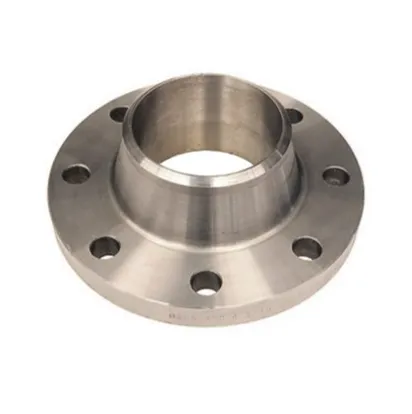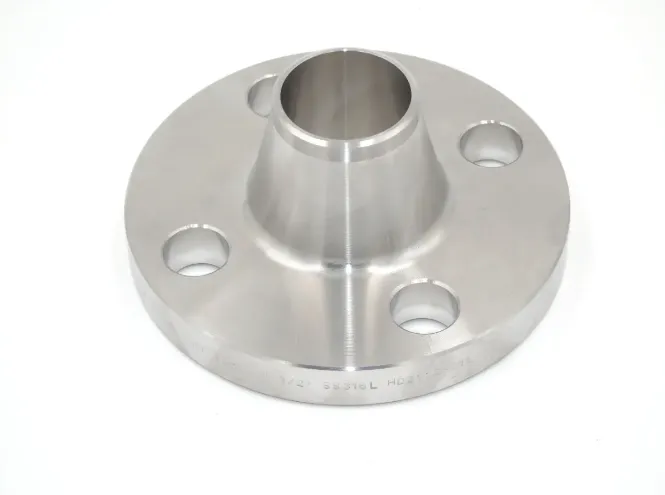General Introduction
Tausiga masani: ANSI B16.5 is a widely recognized American standard that specifies the dimensions, tolerances, materials, and pressure-temperature ratings for pipe flanges. The raised face weld neck flange complies with this standard, ensuring its interchangeability and compatibility in piping systems both in the United States and globally.
Function: It is a crucial component in piping systems, mainly used to connect pipes, valves, pumps, and other equipment. It allows for easy assembly, disassembly, and maintenance of the piping system while providing a reliable connection and sealing.
Design and Structure
Raised Face: The raised face feature provides a better sealing surface compared to a flat face. There is a raised circular area in the center of the flange face. When the flange is connected, this raised part mates with the gasket to form a tight seal, which can effectively prevent leakage and is suitable for applications requiring a high level of sealing integrity.
Weld Neck Design: The weld neck flange has a long, tapered neck that is designed to be welded to the pipe. The neck provides additional strength and support, and the tapered shape helps to distribute stress more evenly, reducing the risk of stress concentration at the connection point. This design is particularly suitable for high-pressure and high-temperature applications where a strong and reliable connection is required.
Dimensions and Specifications
Diameter: Available in a variety of sizes, typically ranging from NPS 1/2 to NPS 24 as per ANSI B16.5 standard.
Materials
Commonly used materials for ANSI B16.5 raised face weld neck flanges include carbon steel, stainless steel, alloy steel, etc. Carbon steel flanges, such as those made of A105 material, offer good strength and durability at a relatively low cost and are suitable for general-purpose applications. Stainless steel flanges, like those made of 304 or 316 stainless steel, have excellent corrosion resistance and are often used in corrosive environments, such as in the chemical and food processing industries.
Pressure-Temperature Ratings
The ANSI B16.5 standard assigns specific pressure-temperature ratings to these flanges. For example, a flange rated for a certain pressure at room temperature may have a different allowable pressure at higher temperatures. It's essential to select the appropriate flange with the correct pressure-temperature rating to ensure the safe and reliable operation of the piping system.
Applications
Industries: Widely used in various industries including oil and gas, chemical processing, power generation, water treatment, and pharmaceuticals. In the oil and gas industry, they are used in refineries, pipelines, and offshore platforms. In chemical plants, they are used to connect pipes that transport various chemical substances.
Specific Scenarios: Ideal for applications where high pressure, high temperature, and high reliability are required, such as in high-pressure steam pipelines, high-pressure chemical transfer lines, and in critical sections of piping systems where leakage must be strictly prevented.
-
Cangzhou Yulong Steel Co., Ltd.
-
Telefoni:
+86 13303177267 -
imeli:
admin@ylsteelfittings.com
- Igilisi
- Alapi
- Italia
- Sipaniolo
- Portuguese
- Siamani
- Kasaka
- Persian
- Greek
- Falani
- Lusia
- Polish
- Fa'a Thai
- Indonesian
- Vietnamese
- Zulu
- Kolea
- Uzbek
- Leai
- Serbian
- Malay
- Ukaraina
- Gujarati
- Haiti Kereole
- Hausa
- Havaii
- Eperu
- Miao
- Hungarian
- Icelandic
- igbo
- Aialani
- Iapani
- Javanese
- Kannada
- Khmer
- Rwanda
- Aferika
- Alapania
- Amharic
- Armenian
- Azerbaijani
- Basque
- Pelalusiana
- Bengali
- Bosnian
- Bulgarian
- Katalana
- Sepuano
- Saina
- Saina (Taiwan)
- Kosikana
- Croatian
- Czech
- Danish
- Eseperano
- Estonian
- Finnish
- Frisian
- Galician
- Georgian
- Kutisa
- Kirikisi
- TB
- Latina
- Latvian
- Lituaniana
- Lusemipoukisi
- Macedonian
- Malagasy
- Malayalam
- Maltese
- Maoli
- Marathi
- Mokoliana
- Myanmar
- Nepali
- Norwegian
- Norwegian
- Occitan
- Pasato
- Siamani
- Punitapi
- Lomani
- Samoa
- Sikotilani Gaelic
- Igilisi
- Shona
- Sindhi
- Sinhala
- Slovak
- Slovenian
- Somali
- Sundanese
- Swahili
- Swedish
- Tagalog
- Tajik
- Tamil
- Tatar
- Telugu
- Turkish
- tamaloloa Take
- Urdu
- Uighur
- Uelese
- Fesoasoani
- Yiddish
- Yoruba

Tusi lau savali iinei ma lafo mai ia i matou
Tala Fou Fesootai
-
Iul. 23, 2025Pulea Feso'ota'iga Fa'asao Avanoa: Fa'afefea e le 1/2 Pipe Nipple's 50mm Fuafuaga Pu'upu'u Fo'ia Lu'itau Fa'apipi'i Pipa?I le labyrinth o masini falegaosimea, lea e lalagaina ai paipa i va 200mm-lautele ma taua uma millimita, o le taua faasaga i nofoaga vaapiapi e masani ona taofia galuega faatino.
-
Iul. 23, 2025Fa'asagaga o A'afiaga o le Fa'a'a'a'esega o le Kasa: Fa'afefea ona pasia e le ASME B16.47 le Fuafuaga Fa'ameamea a le Flange i Su'ega Seismic?I totonu o le tulaga maualuga o le su'eina o kasa shale, lea e lamatia ai le amio sa'o o le paipa, o le ASME B16.47 flange e tula'i mai o se puipuiga taua.
















